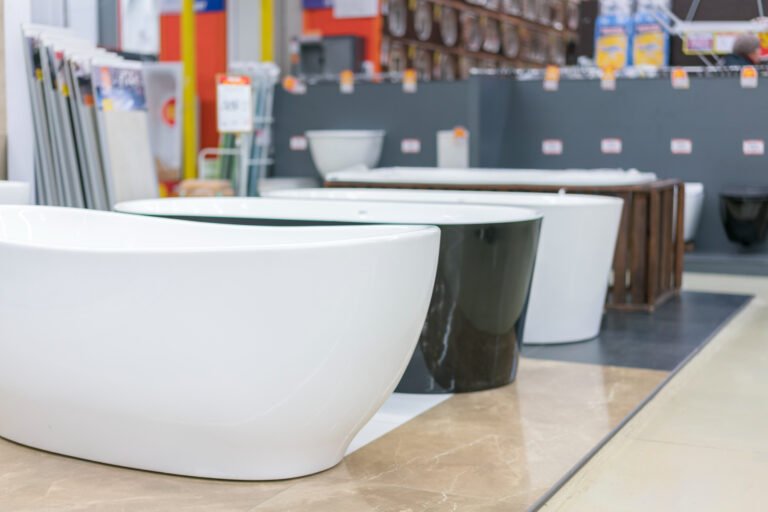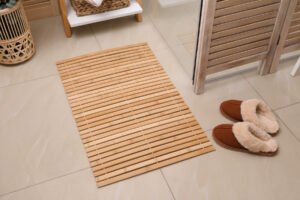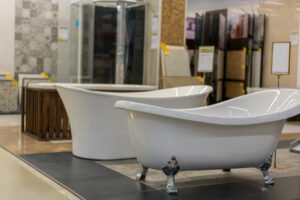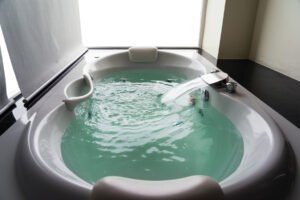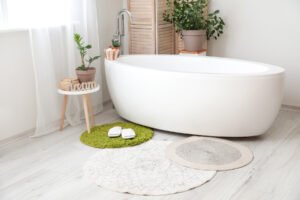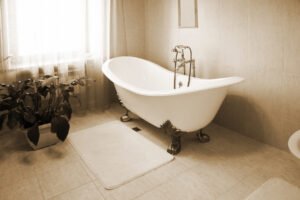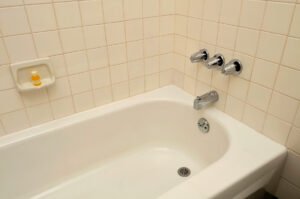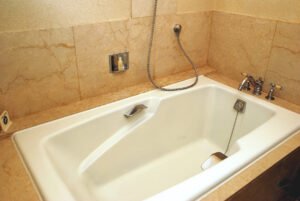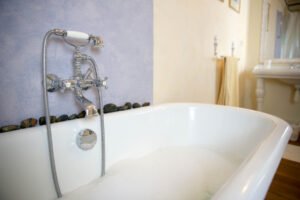Bathroom remodeling does cost a fortune. Bathroom fixtures are not only expensive themselves but incur additional installation, maintenance, and replacement charges that might get heavy on the pockets.
However, using the right materials for all fixtures, including the bathtub, can reduce costs and ensure efficiency in the long run. The tub material impacts the bathtub’s longevity, heat, and scratch resistance, weight, shape, and usability.
Since bathtubs come in various shapes and finishes, it might be helpful to know each material’s costs, pros, and cons before purchasing. So, here are the 12 best bathtub materials, their key features, prices, and some tips for picking the best one.
Popular Bathtub Materials for an Optimal Bathtub
Bathtub materials have different properties regarding warm water retention, porosity, and longevity. While some materials are flexible enough for custom tubs, others, like acrylic and porcelain, are more brittle and comply with simplistic, modern forms.
Let’s analyze more materials and find the best fit for your needs.
1. Fiberglass
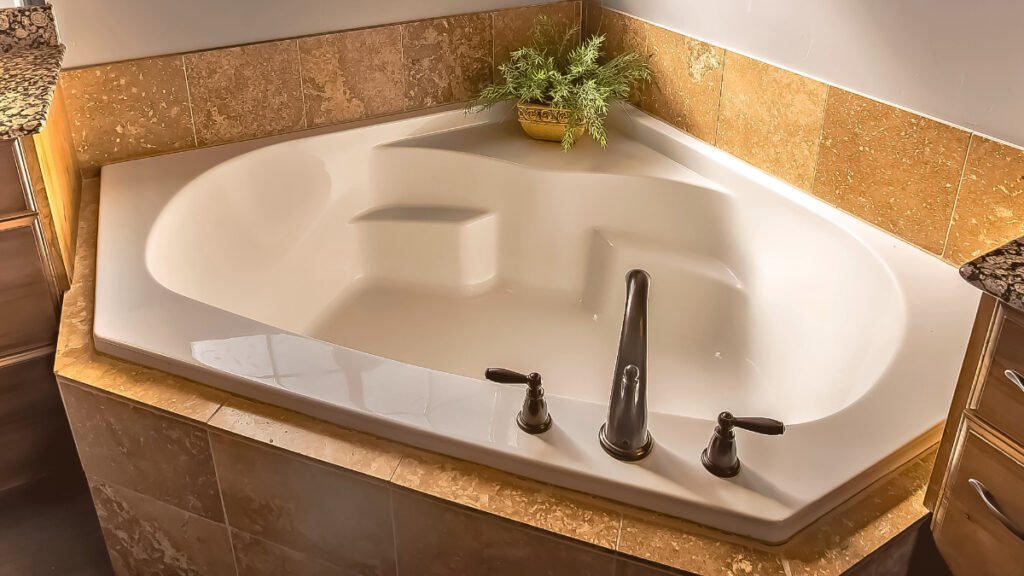
What is it: Fiberglass is a glass or glass-fiber reinforced composite plastic that is weaved and flattened to sheets, bonded with a high-strength resin, and molded to any bathtub shape of choice. It has a top coat of gel-resin or porcelain enamel that makes it look shiny and modern.
Best Preferred For: Customized corner, drop-in, alcove tubs, and even freestanding tubs in a modern, industrial or contemporary setting.
Fiberglass tubs are thin, lightweight, and flexible. They have a high-gloss surface finish that allows easy cleaning and a stain-free surface. However, a fiberglass bathtub is porous and may absorb water and crack easily if not recoated with resin. Moreover, it has a soft surface that bends, warps and does not retain warm water for long.
Though fiberglass is the least expensive material available, its maintenance and cleaning costs don’t make it cost-efficient in the long run. Nonetheless, a fiberglass tub is a right tap for upper-story or apartment bathrooms due to its portability and easy installation.
| Average Lifespan | 10 – 15 years |
| Average Cost | $300 – 800 |
| Standard Weight | 70 – 80 pounds |
Pros:
- Inexpensive, Lightweight, and Portable
- Easy to Install, Repair, Clean, and Replace
- Does not decay and break due to rodents
- Allows installation of showers and faucets on the bathtub surface
Cons:
- Vulnerable to Stains, Cracks, Fungi-attack, and Mildew
- Warps easily and might feel unstable
- Absorbs water and might discolor
- Poor heat retention
- Limited color options and finishes
Warning: Never use harsh chemicals, abrasive cleaners, metal pads, or scourers to clean your fiberglass tub, as these may scratch and discolor the surface. Instead, use ordinary dish soap and mild white vinegar to remove the stains, if any.
2. Acrylic
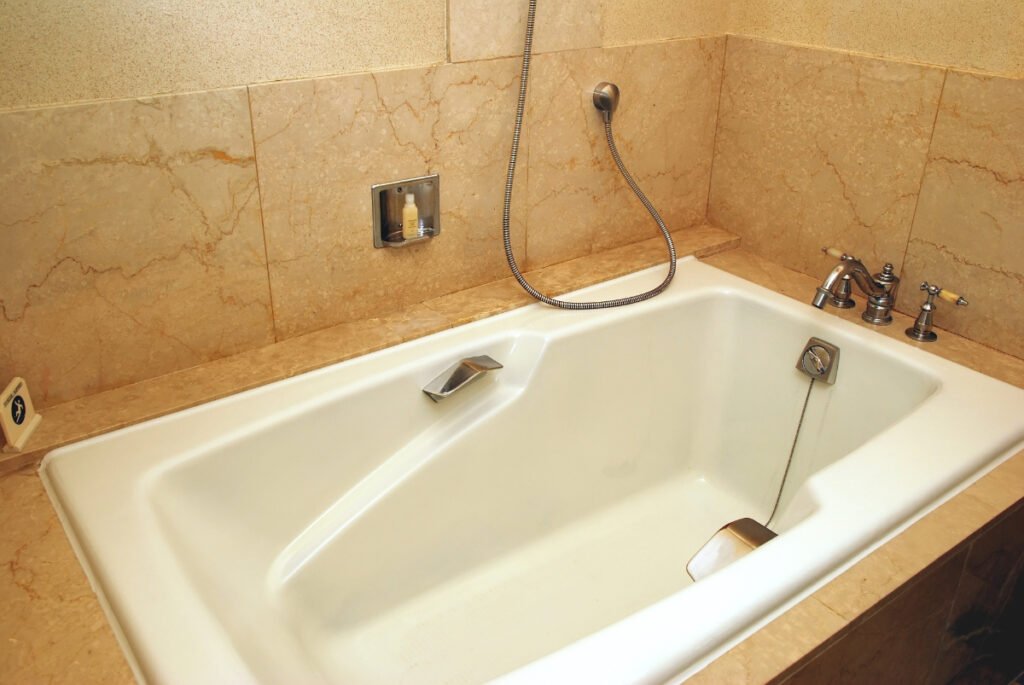
What is it: Acrylic is a comparatively thick and transparent thermoplastic polymer made by fusing petrochemicals, stabilizers, resins, and fillers. It has thermal glass reinforcements that make it stiff, strong, and non-porous.
Best Preferred For: Any larger freestanding bathtub – clawfoot tub, soup-bowl tub, soaking tub, or a jetted jacuzzi or whirlpool tub.
Acrylic baths are lightweight, easy to mold, and have a double-layer insulating system that prevents heat loss and retains warm water. Moreover, an acrylic tub is thicker and non-porous; thus, it withstands pressure and does not bend, warp, or chip. Plus, acrylic resists molds and stains without much maintenance and cleaning.
However, acrylic degrades with bleach, vinegar, or other abrasive cleaners and might turn yellow with frequent cleaning. Moreover, it is vulnerable to scratches and hairline cracks; thus, an acrylic bathtub does not look high-end or luxurious. Overall, however, an acrylic tub is more convenient, cost-efficient, and easy to install.
| Average Lifespan | 15 – 20 years |
| Average Cost | $600 – 1000 |
| Standard Weight | 75 – 110 pounds |
Pros:
- Easy to Install, Repair, and Maintain at affordable costs
- Does not absorb water and dries quickly
- Acrylic comes in a variety of shapes, colors, and finishes
- Light-weight and portable
Cons:
- Does not withstand cracks and scratches
- Melts and degrades on heavy exposure to chemicals
- Looks unpolished
Cleaning Hack: Spray dilute baking soda solution or mild dish soap powder on the acrylic tub, leave it for 10-15 minutes, and wipe it with a soft rag or soft-bristled toothbrush. Alternatively, rinse the tub with a non-abrasive antibacterial liquid for disinfection.
3. Cast Iron
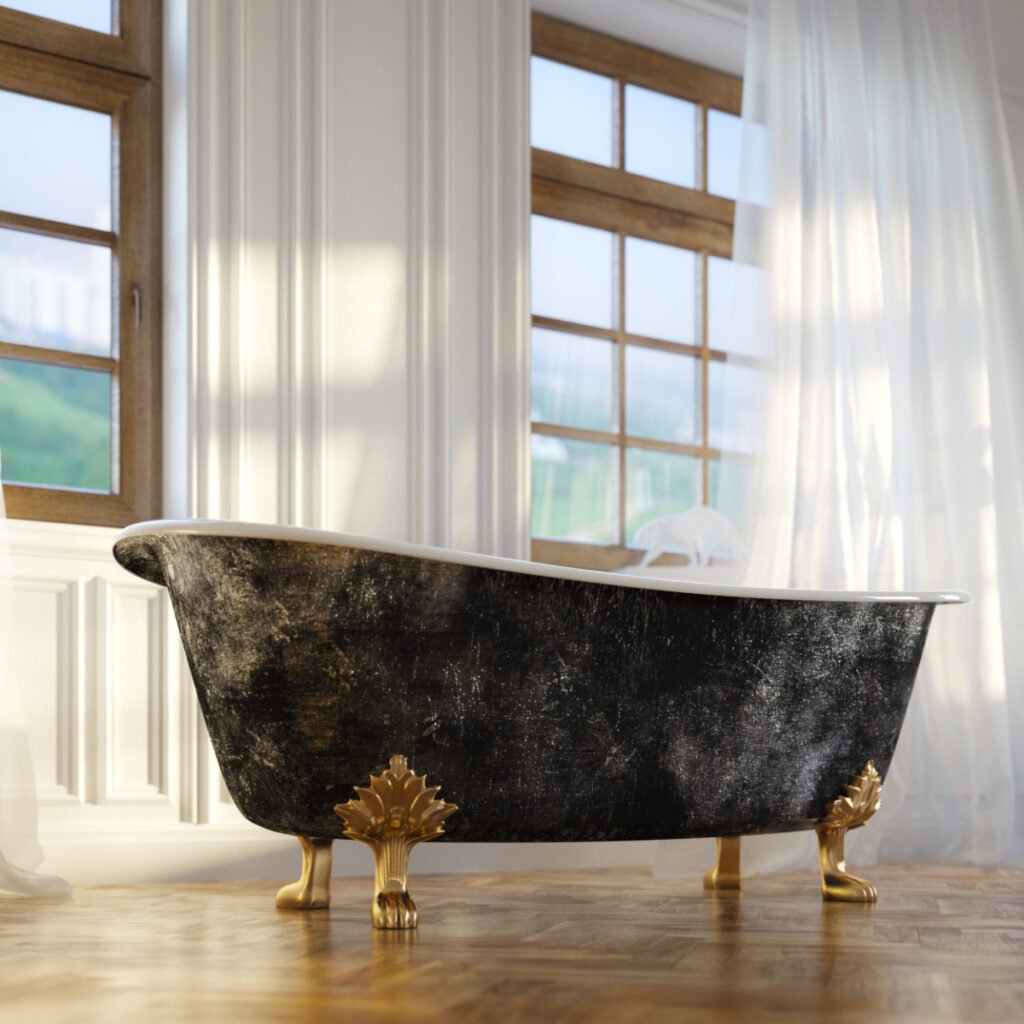
What is it: Cast iron is an alloy of Carbon, Iron, Silicon, and Manganese with slight quantities of Vanadium and Titanium that allow it to be melted and reshaped to different bathtub shapes and sizes.
Best Preferred For: A smaller alcove tub, corner tub, or any small-sized standard bathtub.
Cast iron tubs are the most durable and refinished options for any bathroom to get a luxurious traditional or modern look. These tubs retain warm water for a long and have an enamel surface that prevents cracks and dents. Moreover, a cast iron bathtub has greater impact resistance and allows uniform water temperature inside.
An enameled cast iron tub is stiff and sturdy, balancing heavy weight without buckling. You can easily mold it to any shape or size, paint your bathtub, or finish it with any color, top coat, or anti-rust stain.
However, enameled cast iron tubs are heavy and may require additional floor supports for even weight distribution.
| Average Lifespan | 20 – 22 years |
| Average Cost | $1500 – 2000 |
| Standard Weight | 300 – 500 pounds |
Pros:
- Is the best bathtub to prevent Scratches, Chipping, and Discoloration
- Thicker material and High Heat Retention
- Resurfacable or Reglazable
- Classic, Rustic Look
Cons:
- Heavy and Requires additional support
- High initial cost
- Can rust if the enamel coating goes off
Generally, enamel cast iron tubs resist mold and mildew attacks on their own, but you can easily remove all the fungus by rinsing them with a diluted solution of baking soda and water.
4. Enameled Steel
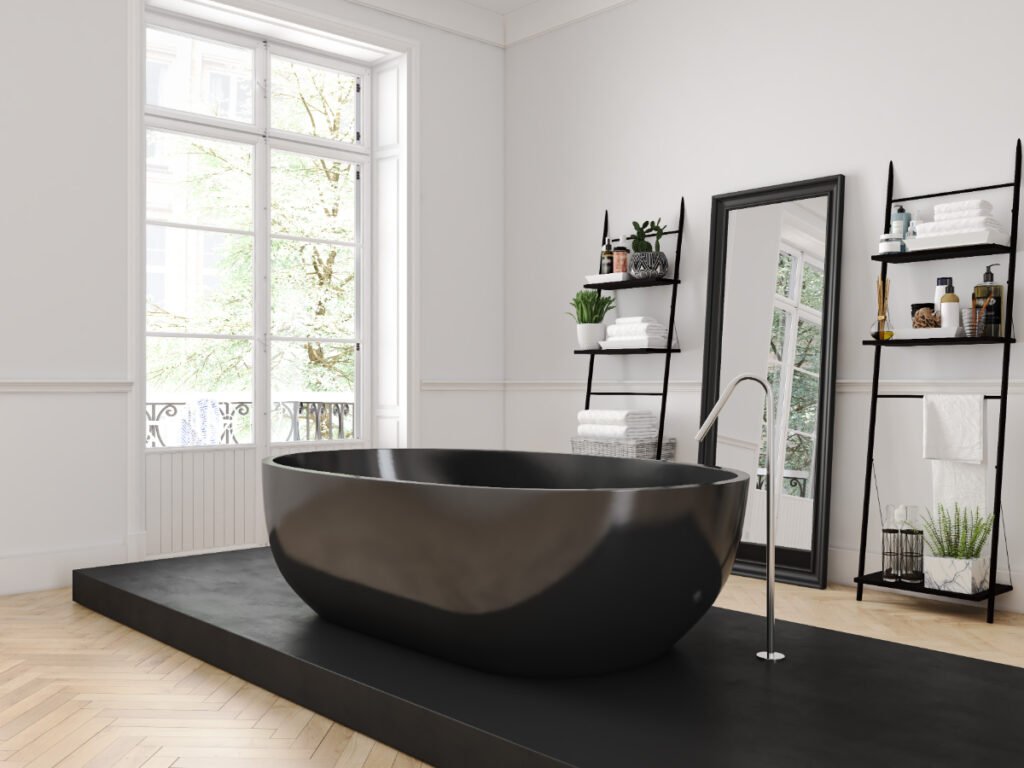
What is it: Enameled steel is a rust-free and abrasion-resistant material, thermally fused with a vitreous topcoat that enhances its strength, color, and heat retention.
Best Preferred For: Larger soaking tubs, jacuzzis, spas, alcove tubs, or to modernize your bathroom remodel.
An enameled steel bathtub is somewhat thinner, lighter, refinished, and inexpensive for industrial or contemporary decor. However, its thinner enamel coating weathers off due to excessive use or cleaning and attracts molds, mildew, or other pests. Plus, it doesn’t retain heat for a long time and needs a water heater.
Further, enameled steel tubs are prone to chipping, denting, cracking, and rusting. Hence, to help them last longer, you’ll need to rinse them properly with an anti-rust solution.
Nevertheless, an enameled steel bath is extremely easy to install. You’ll just need to fasten it by placing wood shims under the tub.
| Average Lifespan | 18 – 20 years |
| Average Cost | $200 – 1000 |
| Standard Weight | 75 – 80 pounds |
Pros:
- Affordable and Long-lasting
- Chemical Resistant and Easy to Clean
- Standard Sized and Stable
- Easy to Install and Repair
Cons:
- Unavailable in freestanding or drop-in alternatives
- Limited design options and finishes
- Can chip, crack, and rust
- Noisy and challenging to move
Steel tubs might cause gurgling sounds during drainage and might need a vent for a smooth flow of wastewater. You can check the steps to install one right here!
5. Cultured Marble
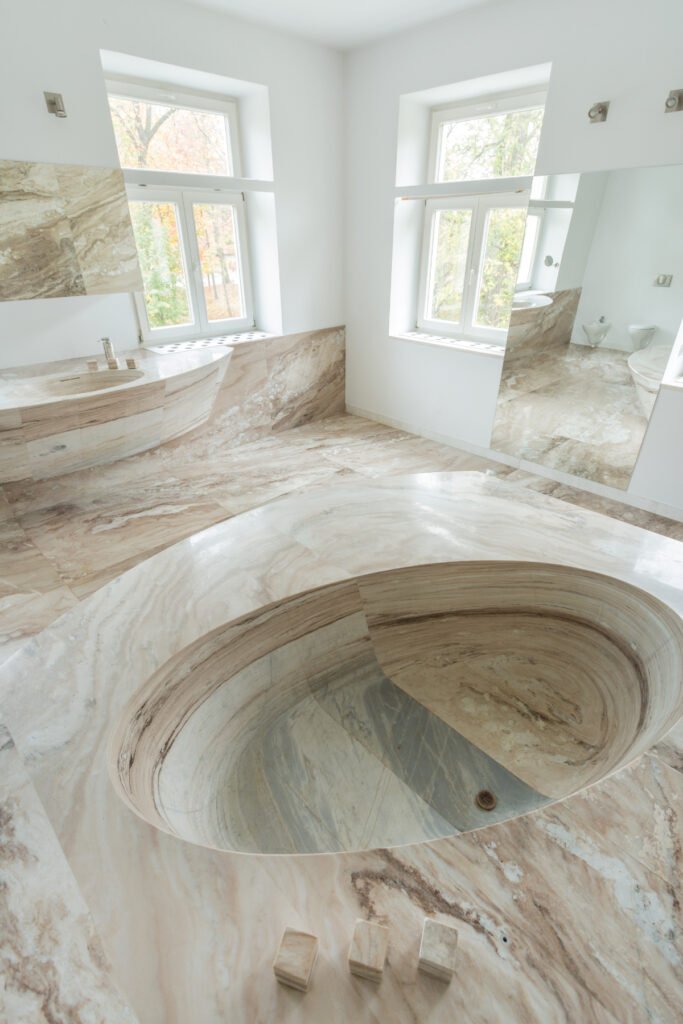
What is it: Cultured marble is a thick sheet of stone particles and quartz bound with various pigments and polymer resins. It is usually available in three textures – Fantasy Marble, Granite, and Onyx.
Best Preferred For: Bateau tubs, Pedestal tubs, or freestanding clawfoot tubs.
Cultured marble tubs are highly versatile and come in assorted shapes, sizes, textures, and colors that look Roman or European. They have a thick, solid surface, and while they might be brittle and easily breakable, they retain heat and maintain a uniform water temperature. You can also coat them with silica to enhance their insulation.
However, cultured marble tubs are vulnerable to mold and mildew attacks; thus, you’ll need to clean them with distilled vinegar, soap, and warm water after use.
Plus, they can easily discolor if not maintained correctly and might frequently need a gel to refinish. Also, these are heavy to install and require professional assistance.
| Average Lifespan | 15 – 16 years |
| Average Cost | $1400 – 2000 |
| Standard Weight | 250 – 280 pounds |
Pros:
- Can be custom-made and look luxurious
- Easy to Clean, Fill, Drain, and Repair
- Durable and High-impact resistance
- Sustainable and Retains heat
Cons:
- Expensive to Purchase, Install and Maintain
- Different quality controls depending on the brand and manufacturer
- Weaker finish and top coat
- Inconsistent color
- No warranty
Never pick cultured marble for a hot tub with water temperatures rising above 140℉ as it may chip and weaken the texture of its stone resin. Ideally, you should use a water temperature of 120-125℉.
6. Cast Polymer
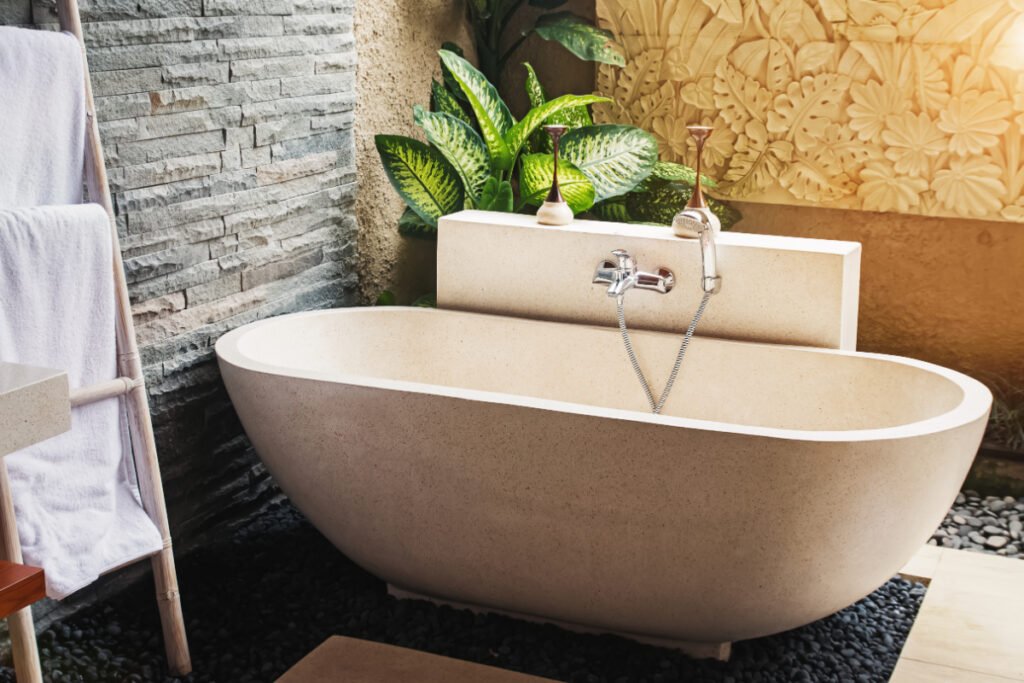
What is it: Cast polymer is a fiber-reinforced bathtub material made by fusing engineered stone, polyester, or any acrylic-based resin and finished with a latex gel coat. The sheets are vacuumed to remove the trapped air and molded into any bathtub shape.
Best Preferred For: Modern freestanding tubs, alcove tubs, under-mount tubs, or simple drop-ins.
A cast polymer bathtub imitates the appearance of faux wood, stone resin, or textured granite and adds a natural, farmhouse aesthetic to any bathroom. It effectively resists dust, mold, mildew, fungus, and scratches but is a bit pricey and looks soiled.
Additionally, its gel coat weathers away gradually, leaving the material prone to cracks, chips, and water leaks.
| Average Lifespan | 8 – 12 years |
| Average Cost | $600 – 1200 |
| Standard Weight | 300 pounds |
Pros:
- Inexpensive and Durable
- Easy to clean and Resists stains, molds, and mildew
- Comes in a variety of colors and finishes
- Surface scratches can be repolished and reglazed again
Cons:
- Heavy and needs additional floor reinforcements and supports
- Needs reglazing frequently
- Breaks on poor maintenance
Warning: Never use all-purpose cleaners, turpentine, lacquer, mineral spirits, acetone, or shower cleaners on the surface of a polymer bathtub as it might discolor and turn white. Instead, clean the tub with mild dish soap or shampoo and water.
7. Porcelain
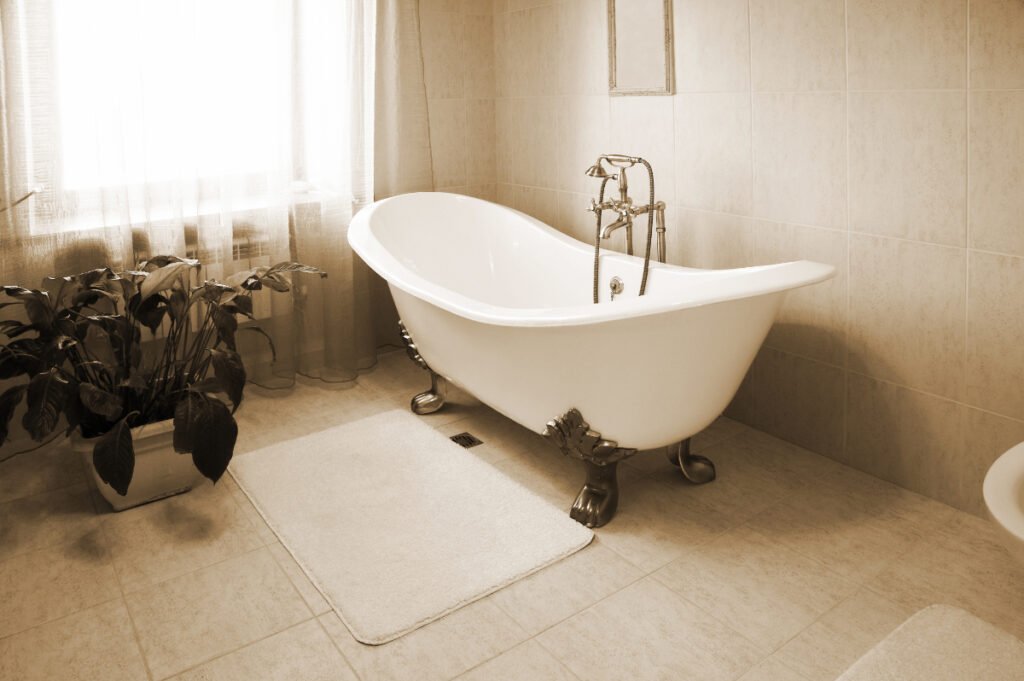
What is it: Porcelain is a vitrified, ceramic-like powder made by heating clay-like materials in a kiln at a temperature of about 2200 to 2600°F. Further, it is converted to a wet paste, reshaped using a bathtub mold, dried, and reglazed for a shiny finish.
Best Preferred For: Sunken or drop-in tubs, alcove tubs, corner tubs, or standard soaking tubs.
Porcelain tubs are lightweight and thin but resist molds, mildew, dust, and scratches. These do not break, warp or crack but do not adapt to custom designs and abstract shapes.
But, they are durable, stain and chemical-resistant, and have a non-porous surface with a shiny top coat. However, they cannot retain heat and might deform under heavy impacts.
| Average Lifespan | 15 – 20 years |
| Average Cost | $700 – 1200 |
| Standard Weight | 250 pounds |
Pros:
- Appear more refined and luxurious
- Increase the home’s resale value
- Smooth, skin-friendly, and does not cause rashes
- Retains its gloss and finish for a long time
Cons:
- Heavy and need professional installation
- Might feel slippery during access
- Can be permanently damaged if rubbed with a scouring pad
- Can rust or discolor easily
You can use a sealing solution from any bathtub repair kit to fill in the hairline cracks or chips from your bathtub. To do so, clean and sand the surface of your tub, spray the solution and finish it with a top reglazing coat to cover any visible scratches.
8. Solid Surface Materials
What is it: Solid surface materials are non-porous, lightweight, but artificial materials made by fusing plastic, epoxy, or acrylic materials and polyester resins with a fire-retardant alumina trihydrate solution.
Best Preferred For: Stationary alcove tubs, corner tubs, soaking tubs, and even under-mount tubs.
A solid-surface bathtub is similar to any standard plastic bathtub but more cohesive and uniform. It does not have separate layers that peel or warp from the surface. Thus, you can resurface or reglaze the tub easily and hide any minor scratches, chips, and stains that might degrade its quality.
However, these tubs are heavy and do not have a protective top coat that prevents abrasion and weathering. Of course, you can coat them with any porcelain enamel stain, but it might incur additional costs and inconvenience. Regardless of the top coat, these are harder, durable, and retain heat efficiently.
| Average Lifespan | 18 – 20 years |
| Average Cost | $600 – 1500 |
| Standard Weight | 250 – 280 pounds |
Pros:
- Non-porous and more durable than gel-coat enamels
- Prevent heat loss and keep the water warm
- Repairable finish and no permanent damage
- Assorted designs and look natural
Cons:
- Heavy and non-portable
- Need to comply with the maintenance codes by the manufacturer
Avoid harsh cleaners, or products that contain bleach, ammonia, or other acids, as these can melt and roughen the surface. Instead, lightly brush the tub using a soft rag or sponge and rinse with cold water.
9. Wood
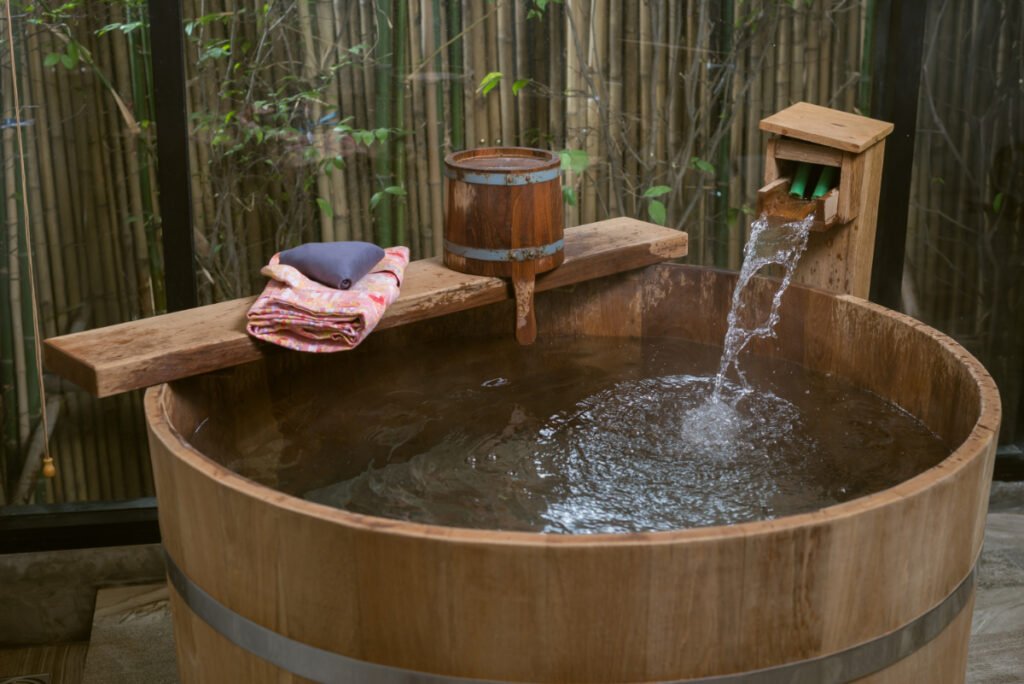
What is it: Wood is a type of porous, fibrous, and natural lumber sliced into planks and joined into rectangular or elliptical shapes using screws and resins. Generally, manufacturers use Cedar, Bamboo, Burmese Teak, Mahogany, and Hickory wood for bathtubs.
Best Preferred For: Larger soaking tubs, free-standing tubs, soup-bowl, or clawfoot tubs.
Wood bathtubs look rich, luxurious yet organic, adding a crisp, mid-century modern aesthetic to contemporary baths and cubicles. However, these degrade with continuous exposure to moisture and might need additional fiberglass or porcelain enamel coatings to last longer.
Nonetheless, wooden bathtubs have the highest heat-retaining capacity and can be used indoors or outdoors. Moreover, though they are easily customizable to any size and shape, they incur huge costs for installation, maintenance, and cleaning and need to be refurbished with anti-termite solutions from time to time.
| Average Lifespan | 10 – 15 years |
| Average Cost | $3000 – 4000 |
| Standard Weight | 500 – 550 pounds |
Pros:
- Prevent heat loss and keep the water warmer
- Luxurious and Natural
- Versatile and easily moldable
Cons:
- Aren’t durable and need protective top coats and structural framing to last longer
- Can dry and rot if left unused for long
- Susceptible to moisture, fungal growth, mildew, and mold
- Expensive and Heavy
Warning: Wood bathtubs might develop a faded, permanent waterline with continuous use. Hence, wash them with mild cleansers after each use and refinish them with a new polyethylene coat annually.
10. Copper

What is it: Copper is a reddish, soft, and flexible element with high thermal conductivity and malleability that allows it to be hammered into various bathtub shapes.
Best Preferred For: Hot tubs, Jacuzzis, Freestanding tubs, and Standard bathtubs.
Copper tubs are rustic, hand-crafted, and luxurious, more famous for their high-end decor than function. These retain heat efficiently but do not offer much insulation from noise and are thin and bendable.
Moreover, these are not lacquered and may gradually turn green and unfinished. But, these tubs are antibacterial and are highly beneficial to the skin.
| Average Lifespan | 15 – 20 years |
| Average Cost | $5000 – 7000 |
| Standard Weight | 120 – 150 pounds |
Pros:
- Ultramodern and naturally resistant to scratches and chips
- Retains heat
- Light-weight
- Antibacterial and Sustainable
Cons:
- Quite expensive and Hard to find
- Needs gentle rinsing after each use
- May turn green with time
Never let your copper bathtub come in contact with acidic solvents like lemon juice or vinegar, as they may react with the surface and discolor it. Instead, use mild dish soap and warm water to rinse it thoroughly.
11. Stone
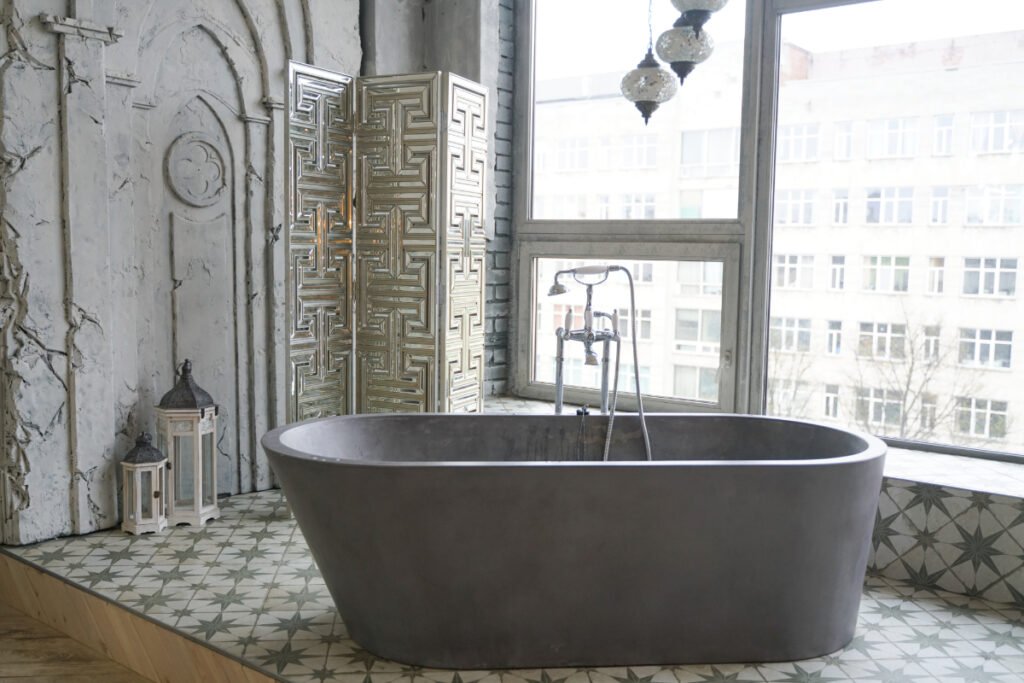
What is it: Naturally quarried stone – marble, granite, or travertine, chiseled and reframed according to a bathtub mold.
Best Preferred For: Freestanding tubs, soaking tubs, or any standard bathtub as per the American Bath Factory.
Stone bathtubs are exceptionally lavish, sturdy, and natural. They offer a thick, insulating bathtub body that not only prevents heat loss but insulates against noise and heavy impacts. They are pretty durable and repairable with silicone fillers or white cement. However, they are cumbersome and might need reinforcements for uniform weight distribution.
Alternatively, a stone resin bathtub can be used for weaker slabs and compact bathrooms. These mimic the look of natural stone and are pretty lightweight and portable. Plus, these come with an enamel top coat and are modern, thinner, and shiny.
Stone Bathtub
| Properties | Stone Bathtubs | Stone Resin Bathtubs |
| Average Lifespan | 100 – 150 Years | 60 – 70 Years |
| Average Cost | $15000 – 30000 | $9000 – 20000 |
| Standard Weight | 1700 – 2000 pounds | 300 – 400 pounds |
Pros:
- Natural, Sturdy, and Customizable
- Cost-efficient to Invest
- Durable and Lasts for long
- Good Heat Retention and Insulation
Cons:
- Heavy and might need floor reinforcements
- Difficult to clean and maintain
- Might react with chemicals and abrasive cleansers
Warning: Never use steel pads, razors, sharp objects, or any solvents like hydrochloric acid, sodium hydroxide or paint thinners on the surface of a stone tub, as these will damage its finish and discolor its surface.
12. Ceramic
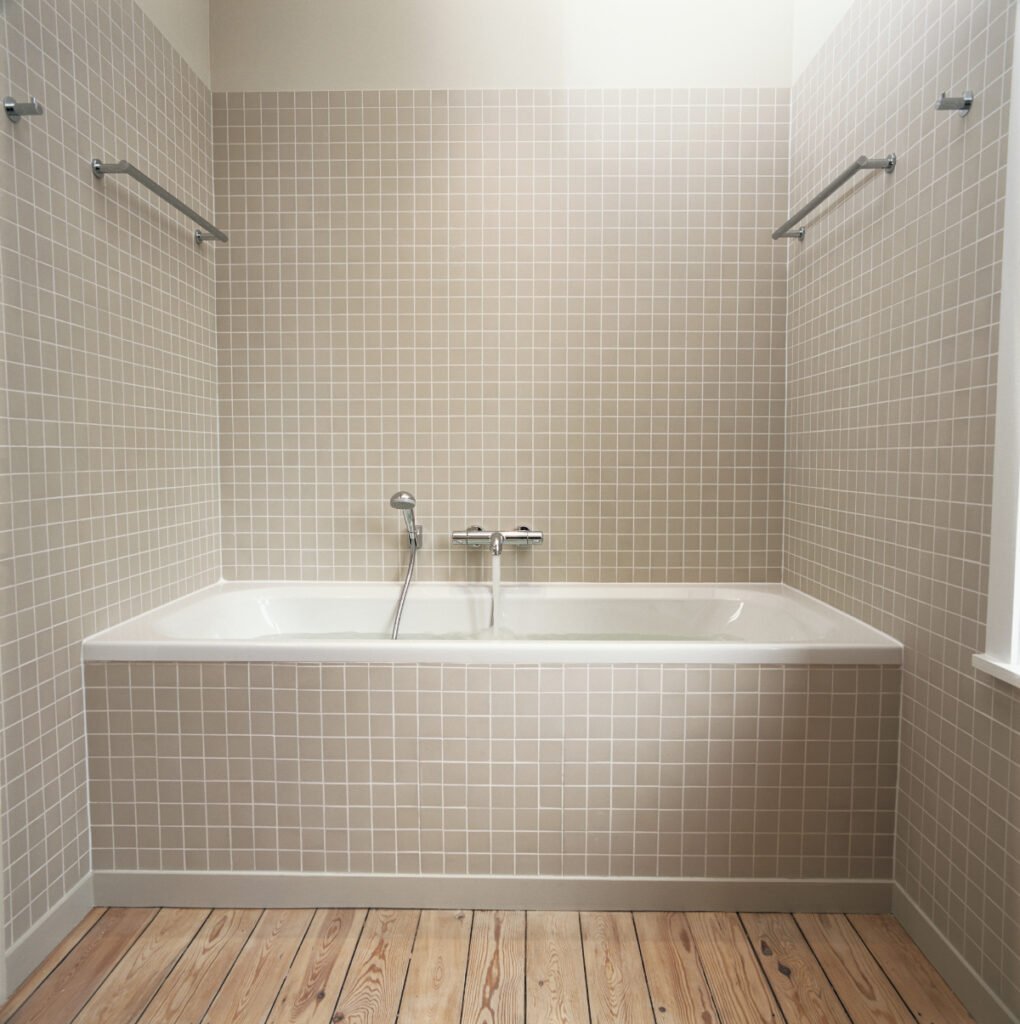
What is it: Ceramic bathtubs are nothing but fused ceramic tiles that are heated at high temperatures and joined with a good binding agent.
Best Preferred For: Smaller alcove tubs, drop-in tubs, paramount tubs, or corner tubs.
Ceramic bathtubs are highly flexible and lightweight and can be molded to any size and shape directly on-site. These hold warm water well but can be noisy and unfinished to look at. Moreover, ceramic bathtubs are brittle and might chip, break, and crack easily, thus directly exposing the sharp grout to the skin.
In contrast, they are pretty smooth if appropriately maintained and come in assorted colors, textures, and finishes that look timeless, despite the bathroom decor.
| Average Lifespan | 20 – 30 years |
| Average Cost | $5000 – 7000 |
| Standard Weight | 200 – 300 pounds |
Pros:
- Ceramic is the best bathtub material for abstract and custom tubs
- Moderately high heat retention capacity
- Nonporous
Cons:
- Difficult to Install, Clean, and Maintain
- Causes skin irritation on breaking
- Reacts with chemicals and abrasive cleaners
- Slightly expensive for larger tubs
You can reglaze a ceramic tub by sanding it a little and recoating it with porcelain enamel to enhance its durability. Reglazing will cost you about $350-600, depending on the tub size.
Tips for Picking the Right Bathtub Material
- Limit brittle materials like porcelain and ceramics for soaking and alcove tubs, and pick stronger materials like acrylic and cast iron to withstand the heavy pressure and drilling in jetted bathtubs.
- Always pick wooden, stone, or fiberglass tubs if you want to install a water heater in your tub, as these won’t turn that hot and burn your skin.
- Choose thinner, lightweight materials like acrylic, porcelain, copper, or steel for second-floor bathrooms.
- Fiberglass or wood tubs might discolor over time. For a timeless option, select polymer, resin, or metal tubs.
- Acrylic, Porcelain, or Ceramic tubs stain easily. Hence, they might not suit kid tubs with many colorful bath bombs inside.
- For heavier bathtub materials like cast iron and stone, you’ll need to brace and reinforce the floor. Additionally, you may use a pedestal to distribute their weight evenly.
Comparison of Popular Bathtub Materials
| Parameter | Enameled Steel | Cast Iron | Acrylic | Fiberglass | Polymer |
| Crack Resistance | Moderate | High | Low | Low | Low |
| Stain Resistance | Outstanding | High | Low | Low | Moderately High |
| Scratch Resistance | Moderate | High | Low | Low | Low |
| Heat Retention | High | Moderate | High | High | Moderate |
| Cost | Moderate | High | Low | Low | Moderate |
| Weight | Light | Heavy | Light | Light | Moderate |
What is the Strongest Material for a Bathtub?
Generally, metal bathtubs such as Cast Iron tubs, Steel, or Copper tubs are stronger than traditional acrylic tubs and do not break entirely on impact. And the additional weight reinforcements and floor supports make them stronger and more durable.
Which Bathtub Material is the Easiest to Clean?
Metal, Porcelain, Polymer, and Copper bathtubs are the easiest to clean as they do not stain or discolor and can be reglazed with simple rinsing and scrubbing. Moreover, most of these have a plastic-like enamel top coat that prevents permanent spots and specks.
Which Bathtub Material is the Best for Soaking?
High heat retention materials like Stone, Stone Resin, Copper, and Acrylic are suitable for soaking as these prevent heat loss and retain warm water longer.
Can Bathtubs Corrode or Rust?
Yes, cast iron, steel, or copper bathtubs may rust if their top enamel coat weathers away and exposes the tub to moisture. In such a case, rinse the tub with an antirust solution, recoat it, or paint it to prevent further corrosion.
Bathtubs are the most exploited fixtures in any bathroom. Hence, they must be built from superior, durable, and repairable materials that not only enhance your soaking experience but are affordable and uplift your decor.
Now that you have our list and guide, it’ll be easier to pick the best bathtub material that suits your needs, sizes, and other considerations. But, if you don’t want a typical, high-maintenance bathtub, you can explore some cool bathtub alternatives for your modern bathroom!

